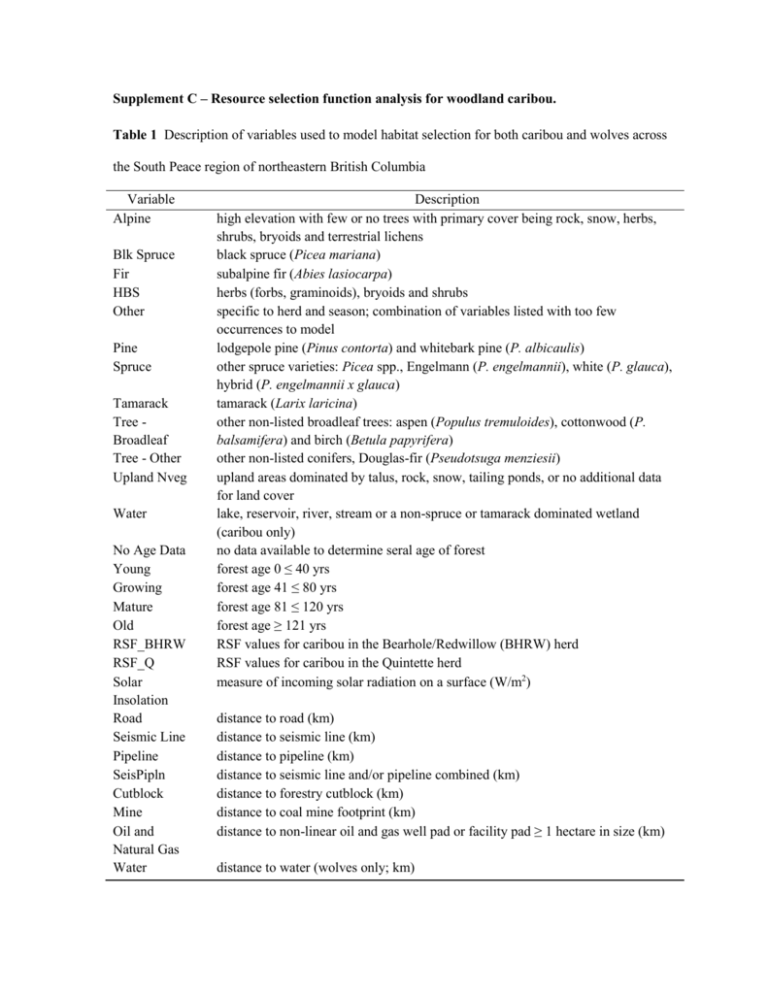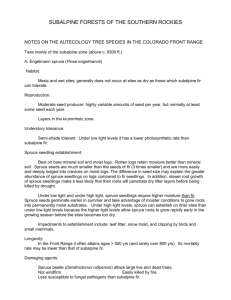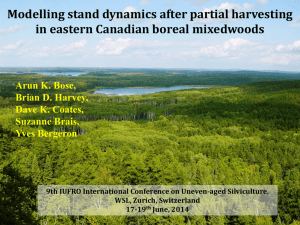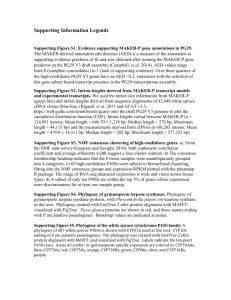Supplement C – Resource selection function analysis for woodland
advertisement

Supplement C – Resource selection function analysis for woodland caribou. Table 1 Description of variables used to model habitat selection for both caribou and wolves across the South Peace region of northeastern British Columbia Variable Alpine Blk Spruce Fir HBS Other Pine Spruce Tamarack Tree Broadleaf Tree - Other Upland Nveg Water No Age Data Young Growing Mature Old RSF_BHRW RSF_Q Solar Insolation Road Seismic Line Pipeline SeisPipln Cutblock Mine Oil and Natural Gas Water Description high elevation with few or no trees with primary cover being rock, snow, herbs, shrubs, bryoids and terrestrial lichens black spruce (Picea mariana) subalpine fir (Abies lasiocarpa) herbs (forbs, graminoids), bryoids and shrubs specific to herd and season; combination of variables listed with too few occurrences to model lodgepole pine (Pinus contorta) and whitebark pine (P. albicaulis) other spruce varieties: Picea spp., Engelmann (P. engelmannii), white (P. glauca), hybrid (P. engelmannii x glauca) tamarack (Larix laricina) other non-listed broadleaf trees: aspen (Populus tremuloides), cottonwood (P. balsamifera) and birch (Betula papyrifera) other non-listed conifers, Douglas-fir (Pseudotsuga menziesii) upland areas dominated by talus, rock, snow, tailing ponds, or no additional data for land cover lake, reservoir, river, stream or a non-spruce or tamarack dominated wetland (caribou only) no data available to determine seral age of forest forest age 0 ≤ 40 yrs forest age 41 ≤ 80 yrs forest age 81 ≤ 120 yrs forest age ≥ 121 yrs RSF values for caribou in the Bearhole/Redwillow (BHRW) herd RSF values for caribou in the Quintette herd measure of incoming solar radiation on a surface (W/m2) distance to road (km) distance to seismic line (km) distance to pipeline (km) distance to seismic line and/or pipeline combined (km) distance to forestry cutblock (km) distance to coal mine footprint (km) distance to non-linear oil and gas well pad or facility pad ≥ 1 hectare in size (km) distance to water (wolves only; km) 4 A HBS 3 Up_Nveg β Coefficients ± 95% CI 2 Blk Spruce 1 Growing Mature Spruce Pine Tam Pipln Road Seis SI Pipln* 0 TreeO -1 Old Young Seis* OG Ctblk LF FOR OG* FOR* -2 -3 No Age Data Fir Alpine -4 5 No Age Data Alpine B Fir β Coefficients ± 95% CI 3 1 Road Ctblk Spruce SI TreeO -1 -3 -5 SI* Water HBS Seis Old Mature Road* Pipln OG MOG FOR Seis* Pipln*Ctblk* OG* LF Mine Young Up_Nveg Growing TreeBL Fig. 1 Coefficients for the parameters in the most parsimonious resource-selection models for Bearhole/Redwillow (A; n = 3,401) and Quintette (B; n = 9,791) caribou herds during the spring season. An asterisk (*) indicates a Gaussian term and variable descriptions are given in Table 1 3 A Tam 2 No Age Data Fir Blk Spruce OG β Coefficients ± 95% CI 1 Road Mature Pine SI 0 Old Spruce -1 OG* Seis YoungGrowing Alpine LF FOR Ctblk* Road* Ctblk Pipln -2 Up_Nveg -3 TreeO -4 No Age Data 5 4 β Coefficients ± 95% CI 3 2 B Alpine Fir Pine Spruce TreeBL 1 SI Up_Nveg 0 Road Old Seis Ctblk Pipln SI* Road* Seis* Young -1 FOR Mine MOG OG* Pipln* Ctblk* OG Mine* LF FOR* Mature -2 HBS TreeO Growing -3 -4 Water Fig. 2 Coefficients for the parameters in the most parsimonious resource-selection models for Bearhole/Redwillow (A; n = 2,200) and Quintette (B; n = 5,868) caribou herds during the calving season. An asterisk (*) indicates a Gaussian term and variable descriptions are given in Table 1 A HBS 3 Tam β Coefficients ± 95% CI 2 1 Up_Nveg Young Old Growing Blk Spruce Pine Seis Pipln SI Ctblk OG FOR* 0 Mature Road Seis* Pipln* OG* LF Fir -1 FOR Alpine Water TreeO -2 Spruce No Age Data -3 No Age Data B 5 4 β Coefficients ± 95% CI 3 2 Alpine Fir Spruce Pine Road 1 SI 0 TreeO Water Young -1 -2 -3 -4 Ctblk OG Seis Pipln Mine MOG FOR Road* Seis* Pipln*Ctblk* OG* Mine* LF Old HBS Mature Growing Up_Nveg TreeBL Fig. 3 Coefficients for the parameters in the most parsimonious resource-selection models for Bearhole/Redwillow (A; n = 8,669) and Quintette (B; n = 22,458) caribou herds during the summer/fall season. An asterisk (*) indicates a Gaussian term and variable descriptions are given in Table 1 6 A No Age Data 5 Blk Spruce Pine Tam Alpine 4 3 β Coefficients ± 95% CI OG TreeBL 2 Road Fir 1 Growing SI Spruce -1 -2 Young Old Mature -3 Seis Ctblk* SI* Road* Seis* Ctblk Pipln LF FOR OG* -4 Water -5 HBS Up_Nveg -6 TreeO -7 3 B Alpine 2.5 No Age Data 2 β Coefficients ± 95% CI 1.5 Road Fir Pine 1 Ctblk 0.5 TreeBL 0 -1.5 Mature TreeOWater Young -0.5 -1 Seis Pipln Spruce Blk Spruce HBS SI Old OG FOR MOG SI* Seis* Pipln* Ctblk* OG* FOR* LF Road* Mine Growing Up_Nveg Fig. 4 Coefficients for the parameters in the most parsimonious resource-selection models for Bearhole/Redwillow (A; n = 11,625) and Quintette (B; n = 28,368) caribou herds during the winter season. An asterisk (*) indicates a Gaussian term and variable descriptions are given in Table 1 Fig. 5 Resource selection map for the Quintette herd during the winter season across the South Peace region of British Columbia, Canada. Four classes represent the range of quality habitat for Quintette caribou










